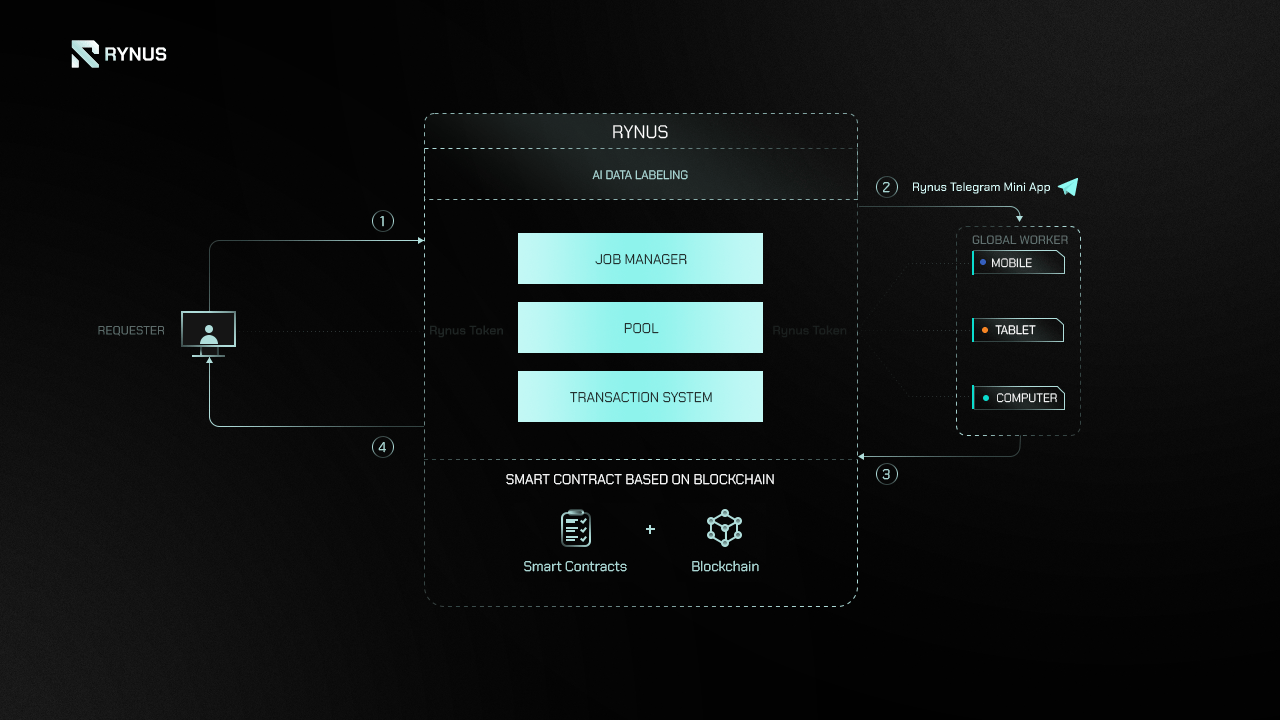Requester, Worker, and Rynus are interconnected to request and perform jobs, pay, and reward with the $RNS Token.
General Model

Rynus General Model
The Rynus model encompasses four key entities:
1. Requester
Requesters are individuals or entities requiring substantial computing power for tasks such as AI model training or Data labeling.
2. Worker
Rynus integrates two types of Workers: GPU Workers and Labeling Workers.
GPU Workers are GPU nodes contributing computational power to the Rynus network. Workers include both Trusted Partners Workers, situated within our local data center, and Global Workers, GPU nodes seeking to join the network.
For Data labeling jobs, Labeling Workers can be any device, from mobile, tablet to PC and laptop.
3. Virtual GPU
Virtual GPUs (or Virtual Workers) are virtual GPU nodes contributing computational power to the Rynus network. They are a fractionalized share of Rynus’s enterprise-grade GPU clusters, including RTX 4090-powered servers hosted in Tier III data centers.

Rynus Advanced Model
4. Rynus
Rynus is a blockchain-based GPU cloud computing network that connects Requesters and Workers. Within the Rynus infrastructure, the following components play crucial roles:
4.1. Job Manager
The Job Manager is responsible for resource allocation and coordination of workers worldwide, including hardware checks and standardization control tasks. Rynus has amassed five years’ worth of standardized data to address these tasks efficiently as well as developed AI bots to optimize task allocation for the best performance. The Job Manager efficiently handles tasks by constructing queues, segmenting jobs into smaller tasks, and distributing them to Workers.
4.2. Pool
The Pool manages the online, offline, busy, available, and unavailable status of Workers, ensuring efficient utilization and availability of computational resources.
4.3. Transaction Manager
Transaction Manager handles payments through the Rynus token and smart contracts that based on blockchain technology. Additionally, Requesters have the option to make payments in fiat currency.
Rynus Flow for Data Labeling

Rynus Data Labeling operates under a SaaS model and offers labeling services for images, text, audio, and video.
Workflow explanation:
- The requester submits Data Labeling jobs on Rynus using the Rynus Cloud and/or Rynus Transfer app.
- The protocol calculates the amount of $RNS tokens required to perform the Data Labeling job. Details are attached to a smart contract and sent across the Rynus.
- Workers use the Rynus Mini app to label data (images, text, audio, and video).
- Once Data Labeling jobs are completed and delivered, $RNS tokens are transferred via the smart contract.
Rynus Flow for AI Training

Rynus Flow for AI Training
Rynus AI Training works under a SaaS model supporting all AI frameworks and libraries.
Workflow explanation:
- The requester submits AI training jobs on Rynus using the Rynus Cloud and/or Rynus Transfer app.
- The protocol calculates the amount of $RNS tokens required to perform the AI training job. Details are attached to a smart contract and sent across the Rynus.
- Workers use the Rynus Worker app integrated with the required AI libraries and software to process the requested AI training job.
- Once AI training jobs are completed and delivered, $RNS tokens are transferred via the smart contract.